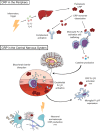C-Reactive Protein: Marker of risk for post-traumatic stress disorder and its potential for a mechanistic role in trauma response and recovery
- PMID: 33131159
- PMCID: PMC8087722
- DOI: 10.1111/ejn.15031
C-Reactive Protein: Marker of risk for post-traumatic stress disorder and its potential for a mechanistic role in trauma response and recovery
Abstract
Increasing evidence indicates that inflammation plays a role in PTSD and stress disorder pathophysiology. PTSD is consistently associated with higher circulating inflammatory protein levels. Rodent models demonstrate that inflammation promotes enduring avoidance and arousal behaviors after severe stressors (e.g., predator exposure and social defeat), suggesting that inflammation may play a mechanistic role in trauma disorders. C-reactive protein (CRP) is an innate acute phase reactant produced by the liver after acute infection and chronic disease. A growing number of investigations report associations with PTSD diagnosis and elevated peripheral CRP, CRP gene mutations, and CRP gene expression changes in immune signaling pathways. CRP is reasonably established as a potential marker of PTSD and trauma exposure, but if and how it may play a mechanistic role is unclear. In this review, we discuss the current understanding of immune mechanisms in PTSD with a particular focus on the innate immune signaling factor, CRP. We found that although there is consistent evidence of an association of CRP with PTSD symptoms and risk, there is a paucity of data on how CRP might contribute to CNS inflammation in PTSD, and consequently, PTSD symptoms. We discuss potential mechanisms through which CRP could modulate enduring peripheral and CNS stress responses, along with future areas of investigation probing the role of CRP and other innate immune signaling factors in modulating trauma responses. Overall, we found that CRP likely contributes to central inflammation, but how it does so is an area for further study.
Keywords: C-reactive protein; biomarker; inflammation; post-traumatic stress disorder.
© 2020 Federation of European Neuroscience Societies and John Wiley & Sons Ltd.
Conflict of interest statement
The authors do not have a conflict of interest, financial, or otherwise. No primary data have been reported.
Figures

Similar articles
-
Psychological therapies for post-traumatic stress disorder and comorbid substance use disorder.Cochrane Database Syst Rev. 2016 Apr 4;4(4):CD010204. doi: 10.1002/14651858.CD010204.pub2. Cochrane Database Syst Rev. 2016. PMID: 27040448 Free PMC article.
-
Early pharmacological interventions for prevention of post-traumatic stress disorder (PTSD) in individuals experiencing acute traumatic stress symptoms.Cochrane Database Syst Rev. 2024 May 20;5(5):CD013613. doi: 10.1002/14651858.CD013613.pub2. Cochrane Database Syst Rev. 2024. PMID: 38767196 Free PMC article.
-
The therapeutic potential of exercise in post-traumatic stress disorder and its underlying mechanisms: A living systematic review of human and non-human studies.Wellcome Open Res. 2025 May 27;9:720. doi: 10.12688/wellcomeopenres.23033.4. eCollection 2024. Wellcome Open Res. 2025. PMID: 40171151 Free PMC article.
-
Biomarkers as point-of-care tests to guide prescription of antibiotics in people with acute respiratory infections in primary care.Cochrane Database Syst Rev. 2022 Oct 17;10(10):CD010130. doi: 10.1002/14651858.CD010130.pub3. Cochrane Database Syst Rev. 2022. PMID: 36250577 Free PMC article.
-
Examining Rates of Traumatic Events and Posttraumatic Stress Disorder Symptoms Among Autistic Adults.Autism Adulthood. 2024 Sep 16;6(3):374-387. doi: 10.1089/aut.2023.0022. eCollection 2024 Sep. Autism Adulthood. 2024. PMID: 39371352
Cited by
-
Post-traumatic stress disorder: evolving conceptualization and evidence, and future research directions.World Psychiatry. 2025 Feb;24(1):52-80. doi: 10.1002/wps.21269. World Psychiatry. 2025. PMID: 39810662 Free PMC article.
-
PTSD, Immune System, and Inflammation.Adv Exp Med Biol. 2023;1411:225-262. doi: 10.1007/978-981-19-7376-5_11. Adv Exp Med Biol. 2023. PMID: 36949313
-
Involvement of the brain-heart axis in the link between PTSD and cardiovascular disease.Depress Anxiety. 2022 Oct;39(10-11):663-674. doi: 10.1002/da.23271. Epub 2022 Jun 16. Depress Anxiety. 2022. PMID: 35708302 Free PMC article. Review.
-
C-reactive Protein/Albumin Ratio as a Prognostic Indicator in Posttraumatic Shock and Outcome of Multiple Trauma Patients.Curr Med Sci. 2023 Apr;43(2):360-366. doi: 10.1007/s11596-023-2714-9. Epub 2023 Mar 21. Curr Med Sci. 2023. PMID: 36943544
-
Stress- and drug-induced neuroimmune signaling as a therapeutic target for comorbid anxiety and substance use disorders.Pharmacol Ther. 2022 Nov;239:108212. doi: 10.1016/j.pharmthera.2022.108212. Epub 2022 May 14. Pharmacol Ther. 2022. PMID: 35580690 Free PMC article. Review.
References
-
- Agorastos, A. , Hauger, R. L. , Barkauskas, D. A. , Lerman, I. R. , Moeller‐Bertram, T. , Snijders, C. , Haji, U. , Patel, P. M. , Geracioti, T. D. , Chrousos, G. P. , & Baker, D. G. (2019). Relations of combat stress and post‐traumatic stress disorder to 24‐h plasma and cerebrospinal fluid interleukin‐6 levels and circadian rhythmicity. Psychoneuroendocrinology, 100, 237–245. 10.1016/j.psyneuen.2018.09.009 - DOI - PubMed
-
- Baker, D. G. , Ekhator, N. N. , Kasckow, J. W. , Hill, K. K. , Zoumakis, E. , Dashevsky, B. A. , Chrousos, G. P. , & Geracioti, T. D. Jr (2001). Plasma and cerebrospinal fluid interleukin‐6 concentrations in post‐traumatic stress disorder. NeuroImmunoModulation, 9, 209–217. 10.1159/000049028 - DOI - PubMed
Publication types
MeSH terms
Substances
Grants and funding
LinkOut - more resources
Full Text Sources
Medical
Research Materials
Miscellaneous

